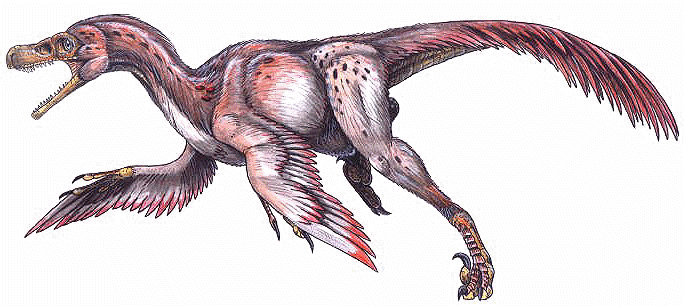|
Bambiraptor is one of the most important fossils found
in North America. This little bird-like dinosaur was a very quick
hunter, and it may have been an important step in dinosaurs' evolution
into birds. Scientists believe that feathers and fuzz covered its
body. The fuzz would have been like the downy covering on baby birds.
Bambiraptor had quite a few features in common with modern
birds. It had a wishbone, something all modern birds have that allow
them to flap their wings, and its arms and hands were very long for
its body size. In fact, the length of its arms and hands approached
the lengths needed for flight. It also had an ossified sternum, a bone
that is essential for birds to be able to move their wings for flying.
Even with these similarities, however, there is no doubt that
Bambiraptor was still a dinosaur from the raptor family. It had
the killer claw on its foot like
Velociraptor, and it had a mouth full of sharp teeth. It is considered by many to be the North American
version of
Archaeopteryx. Clearly a short step away from its European
relative, this specimen is an exceptionally important piece of the
bird/dinosaur puzzle. With more than 90 percent of the animal
discovered, along with the remains of what may be a second individual,
this specimen will continue to provide insight into the evolution of
birds.
The Bambiraptor skeleton was discovered in 1995 by 14 year old
fossil hunter Wes Linster, who was looking for dinosaur bones with his
parents near Glacier National Park in Montana. Linster told Time
Magazine that he uncovered the skeleton on a tall hill and was amazed
at his discovery. "I bolted down the hill to get my mom because I knew
I shouldn't be messing with it," he said. The bones that Linster
discovered on that hilltop led to the excavation of a skeleton that
was approximately 95 percent complete. Because of its completeness
Florida Paleontology Institute Director Martin Shugar compared it to
the 'Rosetta Stone,' the stone tablet that enabled archaeologists to
translate ancient Egyptian hieroglyphics. Yale paleontologist John
Ostrom, who reintroduced the theory of dinosaur-bird evolution with
his 1964 discovery of Deinonychus in Wyoming, agreed, calling the
specimen a "jewel," and telling reporters that the completeness and
undistorted qualities of the bones should help scientists further
understand the dinosaur-bird link.
There is disagreement as to the origin of the name. One
authority wrote that it was named after the familiar Disney movie
character and the surname of the wealthy family who bought and donated
the specimen to the new Graves Museum of Natural History in Florida.
Another points out that Bambiraptor
was a juvenile coelurosaur, and "Bambi" is short for the Italian word "Bambino," which means baby.
The specimen was displayed at the
Graves Museum in Dania, Florida. On March 31, 2004, the board of
trustees agreed to sell the site and dissolve the corporation named
for museum founder Gypsy Graves. They reportedly were looking
for a new location for the museum.
|
![]()
